|
Monday, January 25, 2010
Progress Notes
Miller County has had several community leaders of exceptional abilities some of whom I have discussed previously…. men such as John Ferguson of Iberia, Robert Harvey of Eldon, Bob Marshall of Tuscumbia, and others. Many of these exceptional citizens from our past are listed on the People and Biographies pages located on our website.
But one of the most outstanding examples of one person who pretty much made a town on his own was Civil War veteran James Martin Hawkins of Brumley (photo 01).
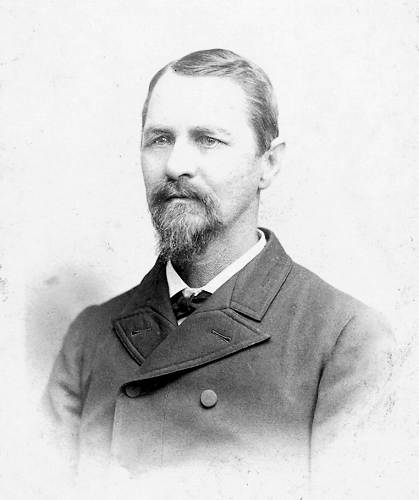
01 James M. Hawkins He was the one who platted the town, gave it its name (the story of which will be told later), established a bank which survived the Great Depression and whose charter was continued later with the Bank of the Lake of the Ozarks, built a huge community hall which for one hundred years was a vibrant and active community center, served at different times for the county as collector, deputy sheriff and member of the county court, and as county representative to the state assembly. He was postmaster for twelve years, instrumental in establishing the Brumley High School, and a charter member of the Brumley Christian Church. He was a charter member of the Brumley Masonic Lodge and was a charter member of the Brumley G.A.R. (Grand Army of the Republic) post, as well as its first commander. And in addition to all this, he was the one who bought the corner property lot from E.C. Thompson to build a general merchandise store which became one of the most successful business enterprises in Brumley. Even after selling the store subsequent owners seemed to be quite successful, including the last one, Glen Shelton (photo 02).
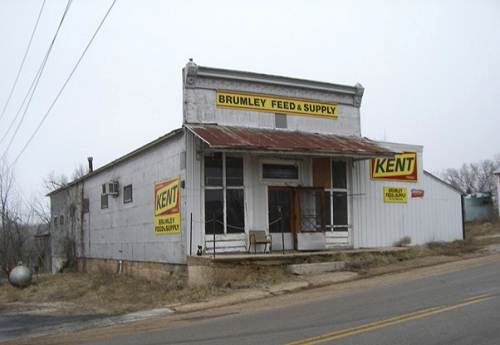
02 Hawkins - Thompson - Shelton Store in Brumley One of James’ sons, Charles Roosevelt Hawkins (known locally as “Ted”) (photo 03) served four consecutive terms as a State Senator for this district.
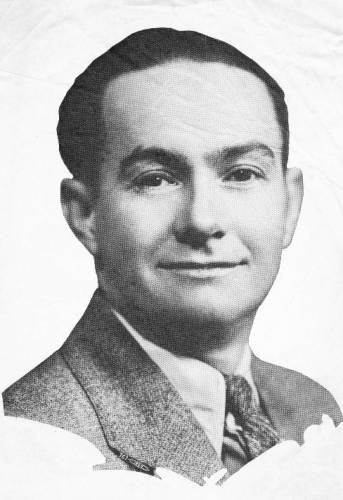
03 Senator Ted Hawkins James’ sister, Cynthia Hawkins Spearman (photo 04), one of the most influential figures in promoting the county’s educational programs, was an inspiring example to those with disabilities as she was a bilateral upper extremity amputee.
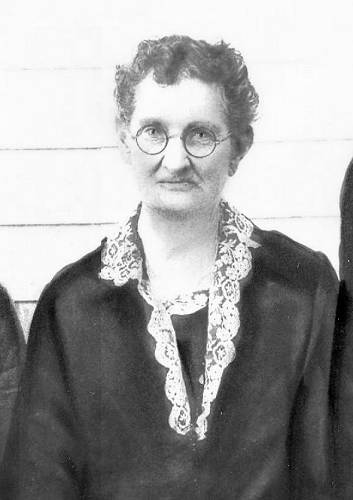
04 Cynthia Hawkins Spearman The story of James and his family is one way to learn the story of Brumley. You can read an abridged history of Brumley by Lucille Crane on our website.
James’ daughter in law, Mabel Hawkins (photo 05), wife of Charles Roosevelt (Ted) Hawkins, wrote a short biography of James as follows:
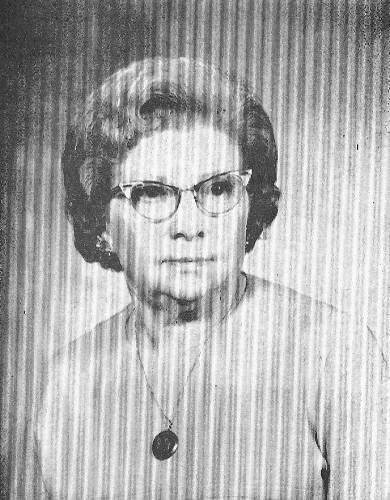
05 Mabel Hawkins James M. Hawkins (photo 06)
1847-1934
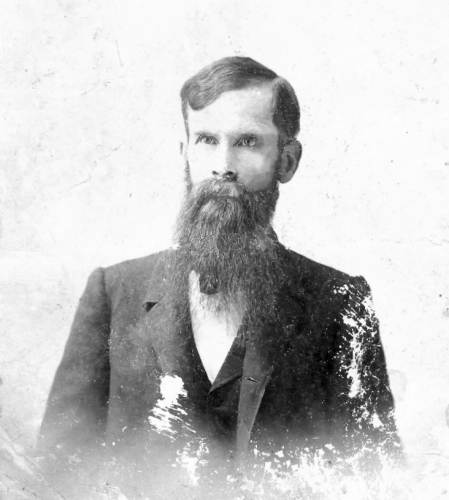
06 James M. Hawkins No history of the Brumley, Missouri area would be complete without mentioning the contributions of J.M. Hawkins and his family to the establishment and growth of the community.
He was born on a farm near what later became the town of Brumley on January 19, 1847. He was the son of Presley and Serepta McCubbin Hawkins who came by wagon to Miller County in 1842…he was a native of Virginia and she of Kentucky.
In 1862 at the age of 14 Mr. Hawkins enlisted in the Union Army (he cast his first vote for Abraham Lincoln while in the Army in 1864). He was discharged in 1865 and returned to the farm in Miller County (photo 07).
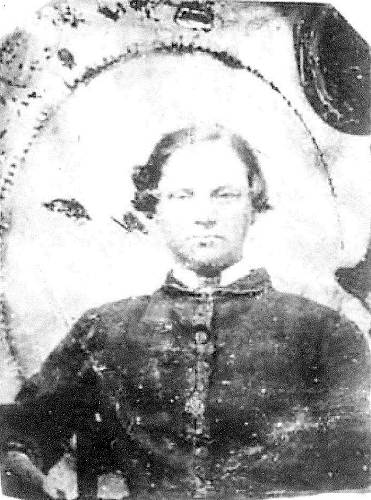
07 James Martin Hawkins
Click image for larger view which contains photo captionMr. Hawkins was married to Miss Julia Ann Martin March 19, 1871 (photo 08).
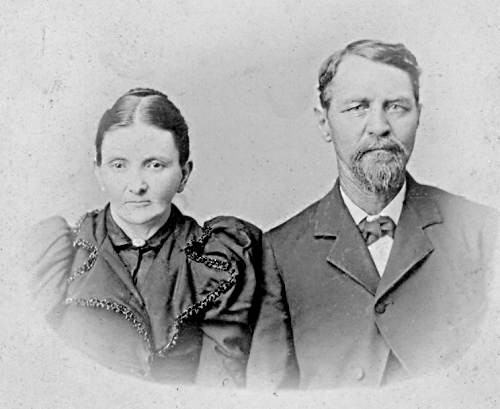
08 Julia and James M. Hawkins They reared a family of seven sons, Edwin P., William Carroll, Phillip C., James Clinton, George Clayton, Robert Perry and Charles Roosevelt (Ted) and four daughters, Lena C., Mary Cora, Nellie Julia and Nancy Ballard (photo 09).
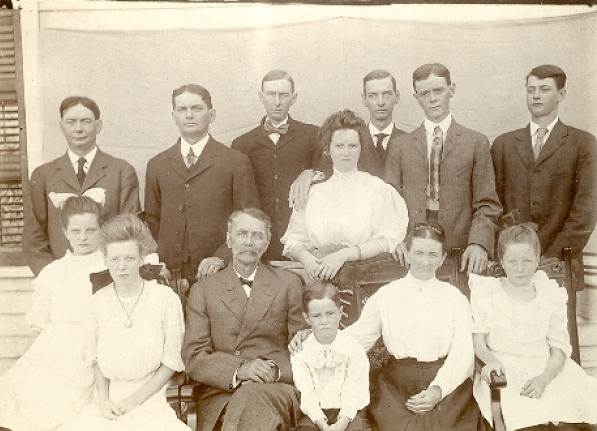
09 James Martin Family
Upper Row: Ed, Carrol, Clint, Clate, Phil, Perry and Lena
Lower Row: Nellie, Cora, James, Ted, Julia and Nancy Mr. Hawkins was a farmer, business man and very much involved in Republican politics in Miller County. In 1872 he was appointed Deputy Sheriff and Deputy Collector under W.C. Brumley and served for four years. In 1877 he platted the town of Brumley (photos 10 and 11).
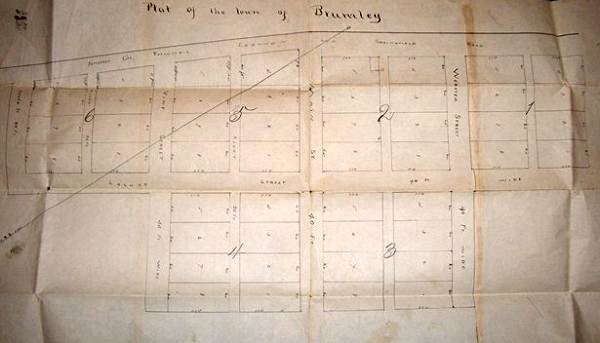
10 Photo of Original Brumley Plat
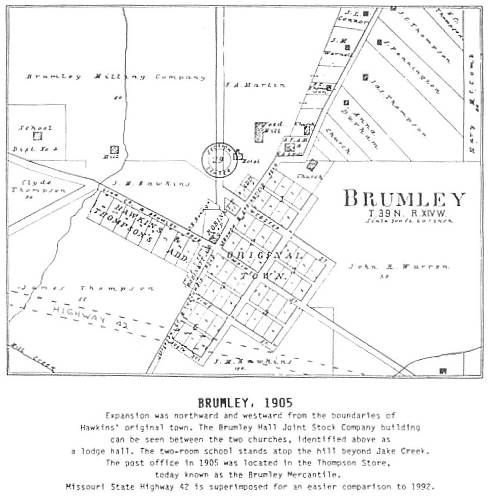
11 Brumley Plat - 1905
Click image for larger viewIn 1880 he bought into the mercantile business in Brumley. The firm was known as Thompson & Hawkins (photo 12).
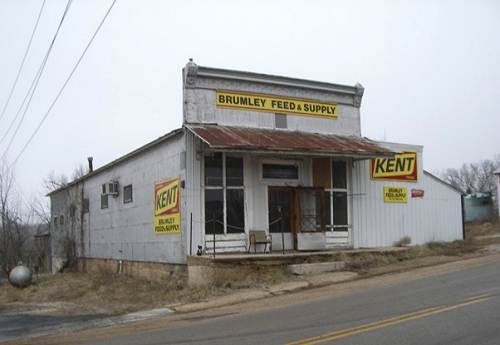
12 Hawkins - Thompson - Shelton Store in Brumley In 1888 he was elected to the Miller County Court from the second district. He was elected Representative of Miller County and served in the 36th General Assembly in 1891 and 1892.
Mr. Hawkins was the first president of the Brumley Milling Company which was organized in 1897. The Mill was constructed and opened for business September 1, 1898.
He was active in all community organizations, being a charter member of the Brumley Christian Church, the Brumley Masonic Lodge and the Grand Army of the Republic.
Although repetitive, I think James Hawkins’ obituary offers a few more interesting details:
Miller County Autogram 1934
Judge Hawkins, Leading Citizen, Died Wednesday
Passed Away At His Home In Brumley; Veteran of Civil War, Former County Official, Active in Religious and Political Affairs of County; Survived by Eleven Children
Judge James Martin Hawkins, who has had a prominent place in the public life of Miller County for more than 60 years, died at his home in Brumley at 9:05 p.m. Wednesday, at the age of 87 years. Several months ago he was stricken with paralysis, but partially recovered, then a month ago he suffered another stroke.
He was born near Brumley September 19, 1847. His father, Presley Hawkns, was a native of Virginia, moved from there to Hart County, Kentucky, thence to Miller County in 1842. His mother, S.B. (McCubbin) Hawkins, was born in North Carolina of Scottish parents. His paternal grandparents were English. He was related to Alvin P. Hawkins, of Huntington, Tennessee, a former governor of that state.
When the Civil War broke out, Mr. Hawkins enlisted in the Union Army at Rolla January 10, 1862. He was discharged for disability, but re enlisted in September 1864, in Company G 45th Missouri Infantry. He was given an honorable discharge on June 28, 1865. He has always taken an active part in G.A.R. affairs, serving in various official capacities (photo 13).
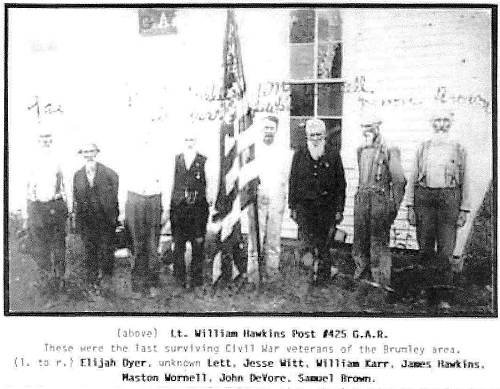
13 Remaining Members of Brumley Civil War Veterans in front of Masonic Hall
Click image for larger viewJudge Hawkins has always been a leader in the Republican party, and wielded a big influence during the active years of his life. In 1864 he cast his first vote, which was for Abraham Lincoln, and he has voted for every Republican presidential candidate since then.
Although unable to walk he was assisted to the polls November 6th last, when he cast his last vote.
In 1873 he was appointed deputy sheriff and collector of Miller County. He was elected in 1888 as a member of the county Court from the Second District, and also served during the years 1891 and 1892 as county representative.
His first business venture was as a merchant at Brumley, soon after his return from the army, he forming a partnership with James Thompson. He was postmaster at Brumley 12 years. He was active in the organization of the Bank of Brumley, served as its first president, and has been cashier of the institution since January 1, 1908.
He always took an interest in school matter, was instrumental in establishment of the Brumley high school and served on the building committee when both the first building and the annex were built (photo 15).
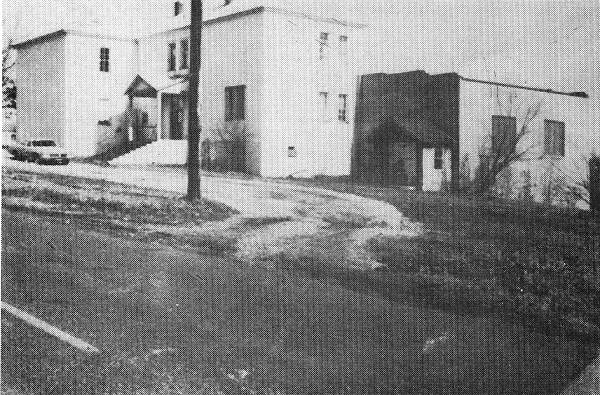
15 Brumley School Judge Hawkins was active in the Christian church at Brumley, of which he was a charter member (photo 16).
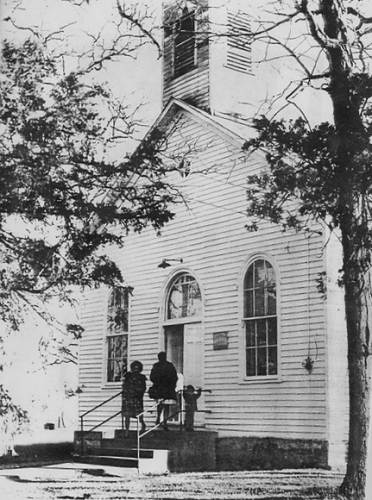
16 Brumley Christian Church - Built 1885 He was always alert in doing what he could in the upbuilding of the community and its institutions. He was a faithful member of the church in attendance and giving of his means. He was an elder in the church many years and until recently was church clerk. He was a regular attendant at both church and Sunday School.
He was affiliated with the Masonic Lodge at Iberia, the last surviving charter member of the Brumley Masonic Lodge, was a charter member of the Brumley G.A.R. post, as well as its first commander.
On March 19, 1871, he was united in marriage to Miss Julia A. Martin, only child of Moses T. and Nancy Reed Martin, who were from Kentucky. From this union eleven children survive him, she having passed away 18 years ago. The children are E.P. Hawkins of Wichita, Kansas; W.C. Hawkins of Buffalo, Missouri; Phil C. Hawkins of Parsons, Kansas; Mrs. Lena Thornsberry of Brumley; Dr. J.C. Hawkins of Blackwell, Oklahoma; G.C., R.P. and Cora Hawkins of Brumley; Mrs. Nellie Pugh of Chicago; Mrs. Nannie Craft and Charles R. Hawkins of Brumley. He also leaves a sister, Mrs. Cynthia F. Spearman of Brumley, and one brother, Millard F. Hawkins of Amarillo, Texas. There are 27 grandchildren and 7 great grandchildren. All the children were present for the funeral.
Note: Here is a photo of the extended family of James M. Hawkins (photo 17), and a handwritten copy of all the names (photo 18):
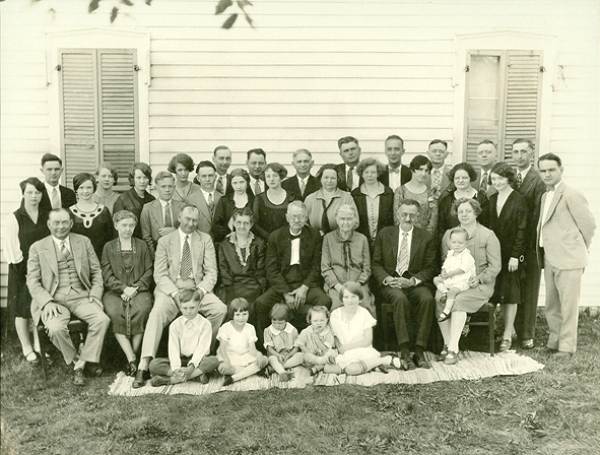
17 Extended Hawkin Family - 1927
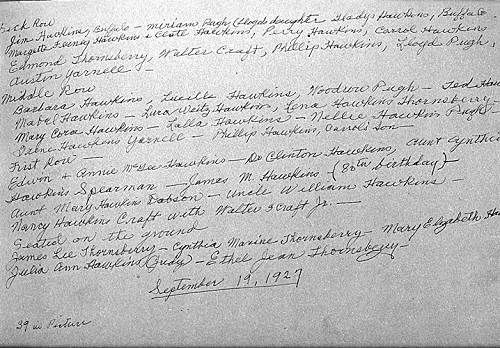
18 Extended Hawkins Family Names
Judy Hawkins Bottom Row Fourth From Left - Last One Living
Click image for larger view
Funeral services were conducted at the Christian Church by Reverend J.C. Thompson (photo 19), one of his closest and dearest friends, in the presence of one of the largest crowds to attend a similar service in Brumley.
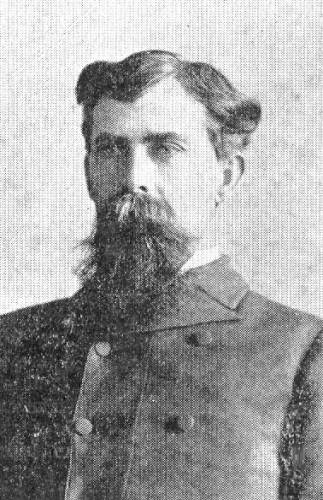
19 James C. Thompson Music was supplied by T.C. Wright, W.S. Stillwell, D.O. Barron and Lawrence Admire as a quartette; and Reverend Crouch (photo 20), pastor of the Brumley Christian Church, rendered a solo.
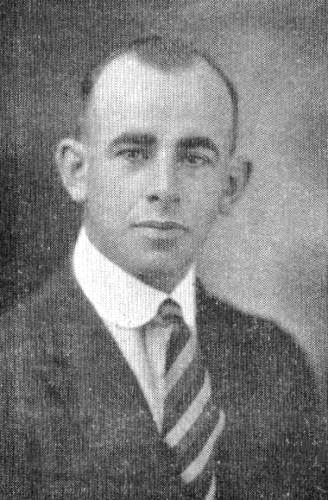
20 Samuel Arthur Crouch Burial arrangements were in charge of Adams & Casey.
His seven sons served as acting pall bearers. Honorary pall bearers were E.C. Thompson, Lee Thornsberry, R.S. Harvey, John Ferguson, R.Crismon, R.L. Reed, W.S. Spearman Clyde Thompson, B.D. Luttrell, Z.T. McCubbin, G.W. Payne, George P. Wall, W.M. Gott, C.H. Clarke, James Dickson, Barney Reed, W.C. Irwin and Dr. Myron Jones.
Following services at the church, the Masonic Order officiated, and the body was conveyed to Hawkins cemetery for burial beside his wife.
In the obituary above one can read a who’s who of Miller County at that time. For example, the choir was a quartet of well respected Tuscumbia men (T.C. Wright, W.S. Stillwell, D.O. Barron and Lawrence Admire). Included in the pall bearers were R.S. Harvey, a leading business man of Eldon, and John Ferguson, one of the most prominent citizens of Iberia. Charles Clarke was another successful business man of Tuscumbia.
One of the most important things understood by James Hawkins was the necessity of a sense of community if a town was to grow and prosper. He began to feel the need to have a central gathering place in Brumley where citizens could meet regularly for social and club activities. So he came up with the idea of constructing a large hall where these ideas and activities could be realized.
Greg Huddleston, whose family has a long history in the Brumley area, has written a narrative about the story of James Hawkins and the “Brumley Hall.” This story is on our website in a section devoted to Greg’s writings about the Brumley area. For a number of years Greg published a journal titled “Mill Creek an Ozarks Heritage Magazine”. We have six of those journal editions on our website.
The article Greg wrote about the Brumley Hall is in Volume 6.
For convenience, I will copy that article here. It offers much in the way of detail and history found no where else; we are grateful for Greg’s research and writing skills and they are well demonstrated in this narrative he wrote about the Brumley Hall:
James Martin Hawkins and the Brumley Hall Joint Stock Company.
Greg Huddleston
“We, the undersigned subscribers to the capital stock of the above named Joint Stock Company, do agree and by these present, and our signatures hereto attached, agree and bind ourselves to pay to the trustees of said company the amounts severally subscribed when and where called upon.”
It was late spring, 1882. J.M. Hawkins sat at his desk penning the document that would help finalize a dream. A dream of a town on a hill. A dream of white washed buildings that housed stores and doctors and schools and churches. It was an aspiring dream. A dream as young as the dreamer himself. Only five years earlier James Martin Hawkins, not yet thirty years of age, had taken it upon himself to lay out and plat boundaries for a new town in southern Miller County. He decided to name the town Brumley after Civil War hero William Brumley. Although the town would owe its existence and development to James Hawkins, James owed something to William Brumley. Five years before, William Brumley had appointed a then relatively unknown James Hawkins to the position of deputy collector rewarding him for his support of Brumley for sheriff. James remembered that favor and returned it by naming the town he was building after Brumley. Years later, in his obituary published in the Miller county Autogram 30 April, 1891, Brumley was quoted as saying, “To him the Republican party of Miller County owes its supremacy today” (photo 21).
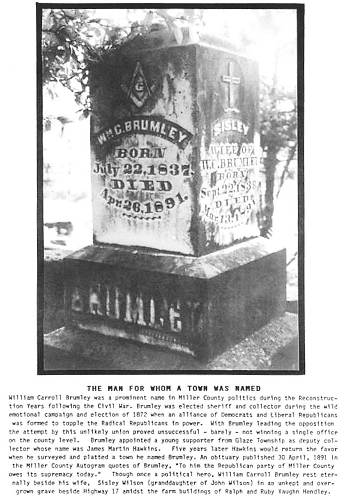
21 William Brumley Tombstone
Click image for larger viewJames Martin Hawkins was born two miles northeast of present day Brumley. He had watched the little village expand from nothing more than a crossroad to a flourishing community. One could say with truth that James Martin Hawkins and Brumley grew up together. Each would become significant to the existence of the other, their futures forever intertwined.
The town’s development began in earnest at the outbreak of the Civil War when a military post was established one half mile to the east along the banks of Mill Creek. A more permanent settlement began to form to service the needs of the nearly 400 militia volunteers at Camp Union. The new year of 1862 saw the soldiers gone, but they left behind the beginnings of a town.
Development began slowly as people, families, and communities struggled to merely survive the horrors and upheaval of the Civil War. The end of the conflict brought the area’s fighting men home. James Hawkins among them, and the Reconstruction Years following the war allowed men of vision the opportunity to step forward and rebuild and reshape lives and communities. For Brumley that man would be James Martin Hawkins.
By 1868 the first store was established at the little crossroads, and Hawkins dream began to form. Growth was steady over the next decade, raising the town to a level of importance as a market and trade center. The settlement became a legitimate entity in 1877 when young James Hawkins filed with the county court of Miller the plat that made his dream a reality, and brought into existence the town of Brumley.
The spark of life was now ignited and James could only watch and wait to see if that spark would burn, or die away. Would others see the vision?
On 6 February, 1878, Lenora Thompson purchased for $20 “Lot 6 in Block 2” of the town of Brumley. One month later, on the 6th day of March, 1878, William Pennington bought Lots 3 and 4 in Block 2 for $25. Piece by piece the little village began to grow.
As Hawkins’ dream prospered so did the town. The thriving atmosphere attracted more and more business. Two general stores were established, two wagon and blacksmith shops were built, a physician had already begun practice while stocking the latest drugs and medicines, a mill was built to serve the agricultural commerce, and a hotel to accommodate visitors and weary travelers. Homes and residences began to spring up.
As wonderful as it was, it was still incomplete. Something was missing. There needed to be a nerve center, a place where the people could meet and conduct social and political and religious business. What Brumley needed was a place for its people to gather as a community, to allow ties and relationships to strengthen, and in so doing, strengthen the community as well. What Brumley needed was a public building, one that would be recognized as belonging to the people. What Brumley needed was a town hall.
Constructing a public building presented some problems, certainly not the least of these being the question of financing. Brumley was not an incorporated village and had neither the power nor authority to collect and disperse funds. Donations would be acceptable but would make it difficult to arrange a building schedule. And what if interest in the project waned before it was completed? A loan could be arranged but the agent granting or holding the note would surely keep the property as security until repayment. Those conditions would hardly make it a public building, at least as long as there was a debt against it. How could a public building be raised without the use of private funds and still remain debt free?
Hawkins answer to that question was quite ingenious. On 29 May, 1882 he established, on paper, The Brumley Hall Joint Stock Company. This company had no office, no assets, no president, and existed only in the driven mind of James Martin Hawkins. He drafted an Article of Agreement for the company, establishing a capital stock of $100 (an amount he was certain would cover construction costs for the town hall). The capital stock of The Brumley Hall Joint Stock Company would be divided into one hundred separate shares, each selling for $1. Whenever the one hundred shares were sold, the company would then be responsible “to build and erect in Brumley a house 18 feet wide and twenty four feet long and 10 feet high.” To assure success of the project those subscribers who preferred could purchase their $1 stock by furnishing material or labor for the building.
Note: Judy Hawkins has the original Article of Agreement for the Brumley Hall Joint Stock Company. It is well over one hundred years in age. I took these photos of it (photos 22, 23 and 24):
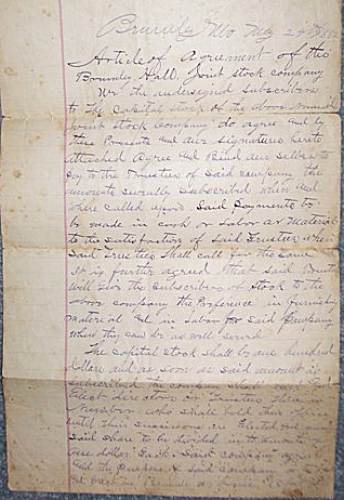
22 Article of Agreement
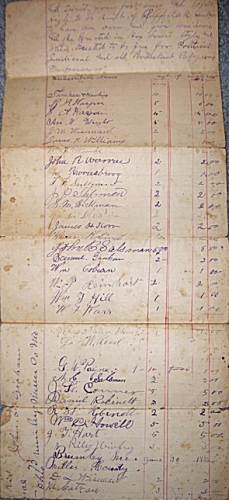
23 Original Signers
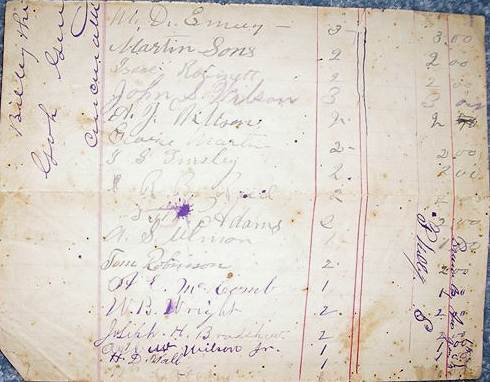
24 Original Signers Under the direction of Hawkins the community building had become a community project, truly “belonging” to the people. From the capital raised during the initial subscription drive the town hall began to rise. These funds apparently proved insufficient to complete the task and on 30 June, 1882 another drive took place. This drive was as successful as the first, the unfinished frame building now tangible proof that The Brumley Hall Joint Stock Company was much more than just an idea in someone’s imagination. Enough interest and curiosity had now been generated that Hawkins was obligated to actually sell more than the 100 shares of capital stock that had originally been declared. But turning down an investor would be more than just refusing a financial venture, it would be rejecting someone who wanted to contribute to their community. Though the project had begun under the charade of business it was no longer that. It was personal. Not just for J.M. Hawkins, but for an entire town.
Within a few short weeks the structure was completed. Brumley had a town hall. It stood near the crown of the hill, the highest point in the little village, easily visible to all the inhabitants. The building was indeed a symbol of and for the unity of a people. From the very beginning, even before construction began, it had accomplished what the spirit of all town halls are meant to represent. The fusing together of a community. It was James Martin Hawkins’ crowning achievement (photo 24a).
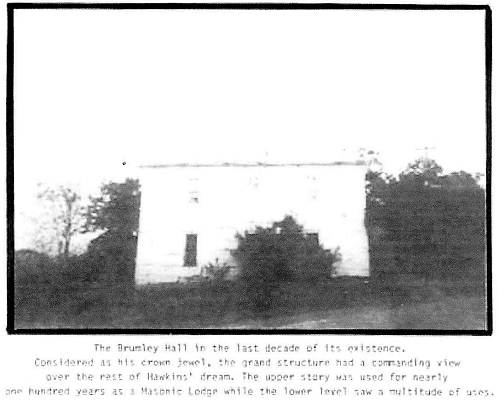
24a Brumley Masonic Hall
Click image for larger viewThe new town hall saw use immediately. Brumley Lodge #203, A.F. & A.M. (Ancient Free and Accepted Masons) organized 27 December 1877, began holding lodge meetings there. In October, 1883, a young minister conducted a series of services at the town hall from which a new congregation was organized, calling itself The Church of Christ at Brumley. An I.O.O.F. fraternity (Independent Order of Odd Fellows) was organized in 1884 and also began meeting there. On 17 April 1889, a charter was granted from the Department of Missouri, G.A.R. (Grand Army of the Republic) to the newly formed Lieutenant William Hawkins Post #425 at Brumley. According to charter agreement this organization of Civil War veterans met on the first Saturday of each month at the town hall. By 1892, the John K. Hall Camp #134 Sons of Veterans of the Union Army of the Civil War had organized and were using the town hall also. There are remnants of information suggesting other clubs and organizations may have used the building also as the 19th century wound down.
Note: we have in our museum on display the original desk used by the Mason organization. It was transferred to Iberia Masonic lodge in later years when the Brumley lodge merged with Iberia. Here are a couple of photos of the desk (photos 24b and 24c):
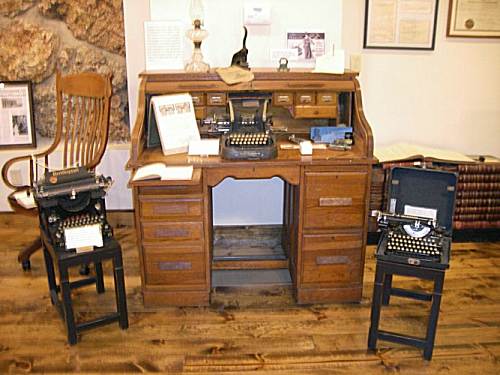
24b Original Brumley Masonic Hall Desk
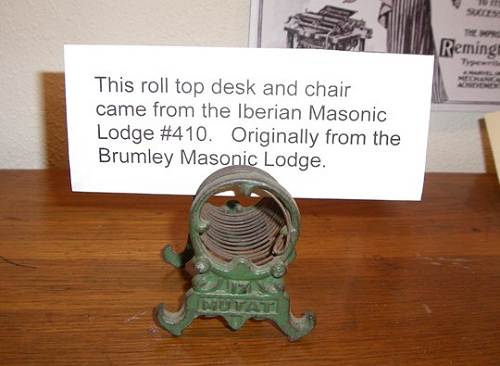
24c Original Brumley Masonic Hall Desk Card The new century began much the same as the old had ended but by the conclusion of the second decade communities everywhere began a subtle change. Men started leaving farms and fields to find employment among area factories and businesses. Those areas that lacked the opportunity for industry witnessed the quiet erosion of their populace as a migration to the larger cities began.
Membership and involvement in the local clubs, lodges, fraternities, and organizations suffered. One by one the various chapters represented in Brumley closed their charters until only the Masonic Order remained.
With the decline of the lodges Brumley’s town hall evolved into something more similar to today’s community buildings, seeing a broad assortment of uses. Although never actually housing a city government the building continued to be the polling place for the Brumley voting precinct. In 1924 the town hall was the location for a season of vocational training for the area blind. During the 1930’s an evangelistic team from Jefferson City frequented Brumley, holding their Pentecostal revival services at the town hall. The year 1939 saw the largest graduation class ever at Brumley High School thanks to the tireless efforts of Superintendent John K. Bear. The trend of growth continued and that fall the enlarged student population occupied every available classroom space, forcing the district to use the room designated as a cafeteria for other purposes. Arrangements were made to continue Brumley’s hot lunch program that school year in the lower level of the town hall, the students walking the short distance separating the two buildings.
Undeniably the most favorite, as well as most recalled use of the town hall were the Saturday night motion pictures shown there. Once exposed to the wonders of the silver screen the community of Brumley provided quite a market to travelling theatre companies. This love affair with Hollywood proved far more than a fleeting fling for Brumley, lasting the better part of three decades. Clare Buster Mace remembers the pew like seating of the 1920’s as she sat entranced by the flickering images on the screen before her. The movies were silent so the only sound was from the chattering hand cranked projector which she believes was owned or operated by the Dickson family. The 1930’s introduced sound and launched the era of the popular Western movies, a big hit with the Brumley crowd. The difficult war years of the 40’s did little to discourage attendance as people sought to escape the constant presence of the terrible conflict. In 1948 Brumley had a movie company of its very own when an enterprising young man rented a 16mm projector and placed screens in Brumley’s town hall and the schoolhouse at Ulman. Robert Martin, while still a student in high school, rented movies from a business in Kansas City and occupied his weekends popping and bagging popcorn and showing movies…every Friday at Ulman and every Saturday evening at Brumley. The price for admittance was 15 cents per child and 35 cents for adults. A bag of popcorn to enjoy while watching the movie cost a nickel. Robert operated his little movie company for a year or so before pursing other interests.
On 21 December, 1972, a Lions Club organization was formed at Brumley. This community oriented program constructed a new and modern facility. All community activities began to be scheduled in the new building. The old town hall then was used exclusively as a lodge building for the still existing Masonic Order.
The end of the year in 1979 also saw the end of the old lodge organizations at Brumley when Lodge #203 Ancient Free and Accepted Masons merged with Iberia Lodge #410. Ownership of the building and grounds in Brumley moved with the Masons and a deed signed 7 January 1982 made it legally so.
The new owners had little need for the property in Brumley. The decision was made to return ownership, in essence, to the people of Brumley by giving it to the two churches in town. Although both church properties adjoined the old town hall grounds the Baptist congregation stood separated from it by a state highway. The Christian congregation, suffering from a limited parking area, would certainly profit most from the property. According to business meeting records the Baptists voted to relinquish their share of ownership in exchange for the lumber and, particularly, the foundation stones beneath the old building with plans to construct a low decorative wall along their section of Locust Street. On 11 February 1982, the Brumley First Christian Church received as a gift from Iberia Lodge #410 possession of the historic lodge building.
The year 1982 was a banner anniversary year for the town hall at Brumley. One hundred years earlier a young man with a dream sat down at a desk and created a fictitious company that would ultimately unite an entire community. The century anniversary of that special occasion wasn’t celebrated with a mass meeting or a community gathering. There were no speakers to address a crowd, no historian to proclaim the significance of the gaunt, old building and the relationship it bore with the little town draped over a hillside. Instead, with little notice and no fanfare, a wrecking crew was assembled and the structure put to the torch where it stood. Once the pride of Brumley, and now viewed only as an abomination, Hawkins’ dream rose in a black smoke and drifted away over the Mill Creek valley. One hundred years earlier construction of the town hall had brought the Brumley community together, but incidents occurring during destruction of the aged building, as if to signify the very changes that doomed it, became sources of disharmony.
Although Hawkins did not name his town after himself he left provision that he would always be remembered. A very curious condition exists in the property deed of the old town hall that has been inherited by the last four owners (Brumley Christian, Iberia Lodge #410, Brumley Lodge #203, Sons of Veterans). It states, in part, that the owner of the property: “shall annually furnish…and place on the graves of all persons who have served in the armed forces of the United States, including any veterans of the confederate Army, a flag of the United States…said flags to be placed at the Hawkins Cemetery, the Gott Cemetery, the Mt. Union Cemetery and the Rodden Cemetery…”
Failure or refusal to keep and perform this condition results in voiding the deed, ownership of the hall and grounds reverting back down the line to the previous owners until one is found who will. James Martin Hawkins made certain he would not be forgotten.
Today, the dream of James Martin Hawkins lives on. It remains a small, rural community where folks warmly return a wave of the hand. A place where a person can stand in the center of town and still hear the lowing of cattle, or look up at night and relish counting the very same stars you counted as a child. It’s a place where time moves slowly. Yet something is missing. A vacant lot now exists where at one time the culmination of an entire community’s hopes and dreams were embodied in a single structure. The wind now blows across the empty void there, gently bending the blades of grass, finding no evidence of the grand accomplishment so long ago of The Brumley Hall Joint Stock Company.
I was very fortunate to have had the opportunity to gather information and many photos having to do with the James Martin Hawkins family from his granddaughter, Judy Hawkins, who lives in Jefferson City, Missouri (photo 25).
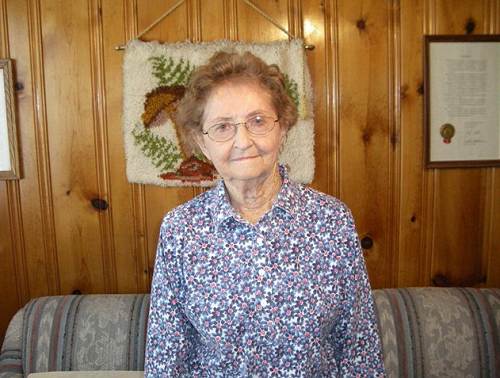
25 Judy Hawkins Judy is the daughter of Charles Roosevelt Hawkins, son of James, who commonly was known as “Ted” Hawkins, one of only five Miller Countians to have served in the Missouri State Senate (photo 26).
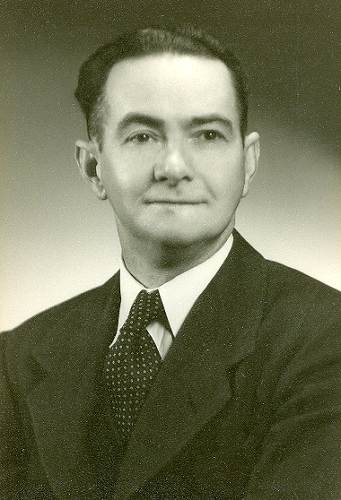
26 Senator Ted Hawkins Almost all the photos and articles I will present in this week’s Progress Notes were made available to me by Judy. Judy was graduated from Brumley High School in 1943 after which she attended Central Missouri State College in Warrensburg. Following that she worked in various government offices in Jefferson City including the Constitutional Convention, the Public Service Commission, and also the State Senate. Following those positions she applied for the position of Director of Personnel and Training of the Department of Public Health where she remained for thirty five years. In that capacity she served also as a consultant to the Missouri State Chest Hospital in Mount Vernon and as a consultant to the Ellis Fischell Cancer Hospital in Columbia. Judy has been a friend of the museum for many years. She is now retired which is a good thing since I took a lot of her time copying all the Hawkins’ family photos and documents for our files. Judy said that her mother, Mabel, was very good at saving and organizing the family’s historical materials. Mabel spent many years as cashier of the Brumley Bank, another of James Hawkins’ enterprises. Mabel was interviewed by the Eldon Advertiser in 1967 regarding her career at the Brumley Bank and later the Bank of the Lake of the Ozarks which I will copy here:
Recalls Experience During Long Banking Career
Eldon Advertiser December 7, 1967
Clare Mace
Mrs. C.R. (Mabel) Hawkins, whose retirement became effective March 3, 1967 after more than 46 years association with the Bank of Brumley and its successor, Bank of Lake of the Ozarks, still keeps in touch with the banking business.
She remains connected with the Bank of Lake of the Ozarks in a consulting capacity. Mrs. Hawkins now makes her home in Jefferson City, but comes to the bank one day weekly.
She recalled many changes during the years she was regularly engaged in her career with the two banks. For her, though, banking business is routine, and she said that, perhaps, the only unusual thing was that she had experienced three bank robberies. The most recent was two years ago this month.
On December 1, 1965, three men, armed and masked, and a woman accomplice escaped with $18,378 from the Bank of Lake of the Ozarks. The stolen car which they used was found abandoned a short distance off Highway 42 about an hour after the holdup.
July 10, 1958, a lone bandit interrupted a bank board meeting at the Bank of Brumley, and made off with $17,749.
In her first robbery experience, in 1933, Mrs. Hawkins was alone in the Bank of Brumley while her husband, then cashier, was away for an hour or so on bank business. Two men with guns came into the bank while two others remained in a car outside. With a gun on each side of her head, Mrs. Hawkins was forced to open the safe. After helping themselves to about $2,000, the robbers had her to get down on the floor, then set a box of loose pennies (which were in the safe) beside her, and told her to “open a bank account.”
Mrs. Hawkins began working when needed as extra help in the Bank of Brumley, where her husband, the late C.R. (Ted) Hawkins, was assistant cashier, after their marriage on August 18, 1920. She recalls that at that time statements were made by hand without the help of an adding machine. The books and ledgers were done with pen and ink, and extra help was needed, especially at statement time each month.
“Ted” was made cashier at the death of his father, the late J. M. Hawkins, and Mrs. Hawkins was elected assistant cashier January 14, 1935. She was elected to the board of directors January 9, 1950 and on March 9, 1956, was made cashier.
Mrs. Hawkins gradually assumed a position of greater responsibility in the bank after her husband was elected state Senator in 1944 from the old 22nd Senatorial District and later from the 33rd district, in which position he served until his death in September, 1959.
The Hawkins family was affiliated with the Bank of Brumley from its opening in 1906 with James Martin Hawkins as president and E.C. Thompson as cashier. Mr. Thompson did not like the cashier’s work, so the following year he and Mr. Hawkins changed positions and so remained until the death of Mr. Hawkins.
C.R. (Ted) Hawkins was the youngest son of James Hawkins.
After the death of C.R. (Ted) Hawkins the Lake of the Ozarks group purchased controlling interest in the bank’s stock and the bank was moved to temporary quarters at Lake Ozark. The name of the bank was changed to the Bank of the Lake of the Ozarks using the Bank of Brumley charter and FOIC insurance. Mrs. Hawkins continued as cashier until her retirement.
Through the 39 years of her association with the Bank of Brumley, the bank depended largely upon farmers and farm related businesses for its growth, and earned the reputation of a sound and prosperous rural bank. The growth in volume of business had been remarkable in the 8 years since it became the Bank of Lake of the Ozarks, she noted, and especially reflects the expanding economy and the impact of the tourist industry in the area.
Mabel Hawkins wrote her own history of the Bank of Brumley which is copied here:
Bank of Brumley
Mabel Hawkins
The Bank of Brumley opened for business October 15, 1906. There were 18 original stockholders. The first Board of Directors were J.M. Hawkins, E.C. Thompson, James Thompson, W.R. Carnes and James C. Warren. The first officers were J.M. Hawkins, President; E.C. Thompson, Cashier; and J.C. Warren, Secretary. In January 1908 E.C. Thompson became President and served in that capacity until his death in 1947. J.M. Hawkins became Cashier and served until his death in 1934 (photo 27).
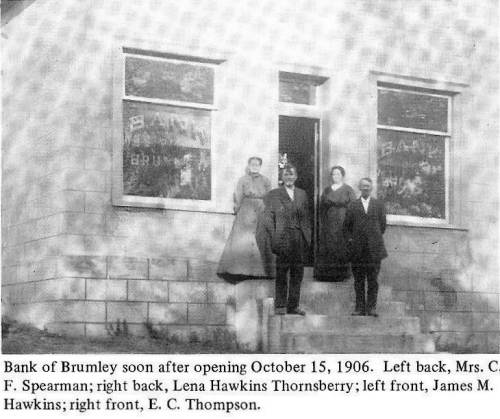
27 Brumley Bank
Click image for larger viewLena Hawkins (later Mrs. W.E. Thornsberry) was assistant cashier from 1910 to 1914. Nellie Hawkins (now Mrs. Lloyd Pugh) was selected to serve as assistant cashier in 1914. She served until 1915 when C.R. (Ted) Hawkins was selected. He served as assistant cashier until his father’s death in 1934 when he became cashier. In 1956 he became President and served in that position until his death in 1959.
Mabel C. Hawkins was selected to serve as assistant cashier in 1934 and became cashier in 1956.
Others who served as President were Lee Thornsberry, Clyde s. Thompson, Elmer Thompson, W.E. Thornsberry and C.B. Bass.
Members of the final Board were C.R. Hawkins, Mabel C. Hawkins, Kent Crane, Ralph Long and Early A. Plemmons.
The Bank of Brumley, although small by today’s standards, was a sound institution and served the needs of the community well. Of special interest to the officers was helping young farmers get a start and especially in helping young students continue their educations.
The Bank always paid dividends to the stockholders. It survived the “Banking Holiday” crisis in 1934 as well as two bank robberies.
Upon the death of C.R. (Ted) Hawkins in 1959, the stock was sold to the group who were in the process of securing a charter and FDIC insurance to start a bank at Lake Ozark. On July 1, 1960 the bank was moved to its temporary quarters in Lake Ozark and the name changed to ‘Bank of Lake of the Ozarks.
Mrs. Hawkins remained cashier until her retirement in 1967. Ralph Long is still serving on the Board of Directors.
In 1956 the Bank of Brumley celebrated its 50th year anniversary. On that occasion, the Miller County Sentinel published an article on the history of the Bank:
Bank of Brumley 50 Years old
Miller County Autogram Sentinel
October 1956
October 15, 1956, the Bank of Brumley will observe the 50th anniversary of their formal opening for business which was October 15, 1906. This banking institution has been in continuous operation ever since its opening date, and through the past 50 years has had thousands of customers who have deposited and borrowed from them amounting to millions of dollars.
There were 18 original stock holders of the bank when it was organized, only one of whom is living, however, he does not hold any stock at the present time. The stock of three of the original shareholders is still owned by their children or grandchildren.
The first board of directors was: J.M. Hawkins, E.C. Thompson, James Thompson, W.R. Carnes and James C. Warren.
The first officers of the bank were J.M. Hawkins, president; E.C. Thompson, cashier and J. C. Warren, secretary.
A change of officers was made in January 1908 when E.C. Thompson became president and served as such until his death in 1941, and J.M. Hawkins took the position as cashier and served as such until his death in 1934.
Mrs. W.E. Thornsberry, formerly Lena Hawkins, was assistant cashier from 1910 to 1914, at which time Nellie Hawkins, now Mrs. Nellie Pugh, was selected as assistant cashier in which capacity she served until 1920 when C.R. (Ted) Hawkins was selected as assistant cashier and served until the death of his father in 1934 when he then became cashier and served in this capacity until 1956 when he was made president of the bank, which position he now holds. Others who served as president wee Lee Thornsberry, Clyde Thompson, Elmer Thompson, W.E. Thornsberry and C.E. bass, all now deceased.
The present board of directors is: C.R. (Ted) Hawkins, Mabel Hawkins, Kent Crane, Ralph Long and E.A. Plemmons.
The present officers are C.R. (Ted) Hawkins, president; Mabel Hawkins, cashier, and Sue Hawkins assistant cashier.
The bank was held up in a day light holdup by four armed bandits in 1934.
In March of 1934, when President Franklin D. Roosevelt closed every bank in the United States by Presidential Proclamation, the officers recall an incident when a farm lady from a distance of about 15 miles, who had never had an account at the bank, came in and insisted that she be allowed to make a deposit. The cashier informed her that they were no permitted under the proclamation to accept deposits. The lady had $300 in silver and currency in a flour sack which represented her savings and insisted that the bank take it. The cashier informed her that they would place the money in their vault and when permitted to reopen and accept deposits would give her credit for it.
The Bank of Brumley, along with all other banks that passed a satisfactory examination, being permitted to again accept deposits gave this customer credit for her $300 and it still remains to her credit to this day.
The total resources of the bank at the close of the first day’s business October 15, 1906 were $12,686.51. The total resources on their 50th anniversary are in excess of $450,000.00.
The Bank of Brumley, along with the other fine banks of Miller County, enjoys a strong, sound financial position, and while this bank is small in size so far as present day banks go, it enjoys the reputation of being one of the fine banking institutions of the state, serving the financial needs of its community and having the confidence of their several hundred customers.
They are a member of the Federal Deposit Insurance Corporation, American Bankers Association and the Missouri State Bankers Association.
The Miller County Sentinel extends congratulations to the Bank of Brumley upon the completion of 50 years of successful banking and extends to them best wished for the future.
The two robberies of the Bank of Brumley in 1934 and 1958 were well covered by local newspapers. If you want to read more about those refer to this collage of copies of the original newspaper reports (click on the thumbnail images for a larger view) (photos 28 - 33):
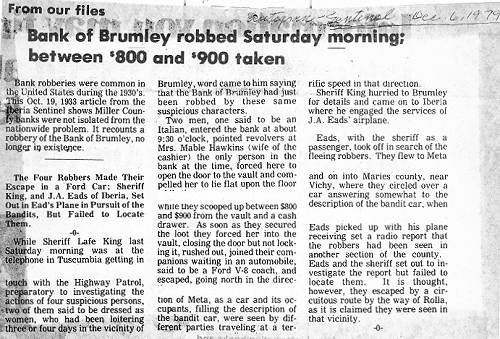
33 Bank of Brumley Robbery - 1933
Click image for larger view
James Martin Hawkins was a devoutly religious man. He was a charter member of the Brumley Christian Church and served many years as an elder. You can read more about the Brumley Christian Church in this collage of photos of the program of the church’s fiftieth anniversary in 1933 (click on the thumbnail images for a larger view) (photos 34 - 40):
Family was very important to James Hawkins. He was proud of his siblings and children and had many photos taken of them. Here are a number of those photos supplied me by his granddaughter, Judy Hawkins (photos 41 - 46):
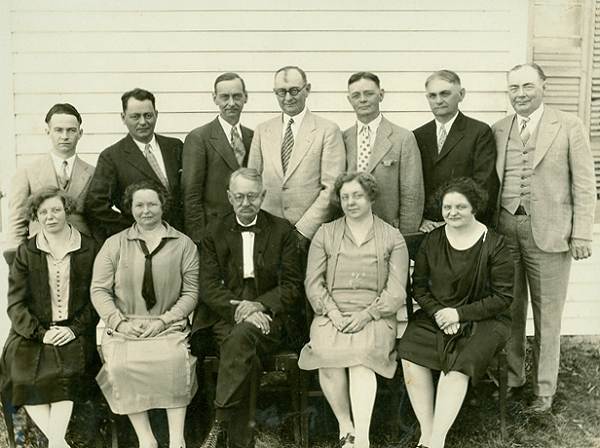
41 James Hawkins Family
Back Row LR: Ted, Perry, Clate, Clint, Phil, Carro and Ed
Front Row: Cora, Lena, James, Nancy and Nellie
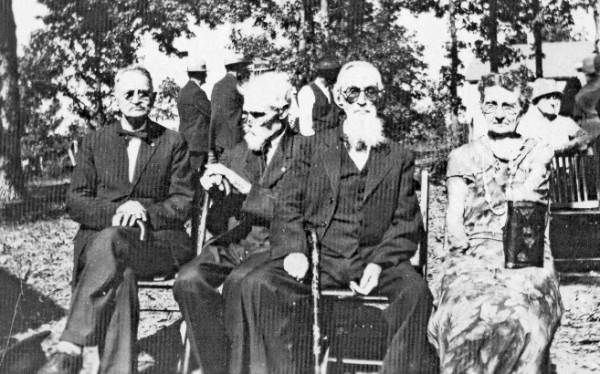
42 J.M. Hawkin (Left) and Cynthia Hawkin Spearman (Right)
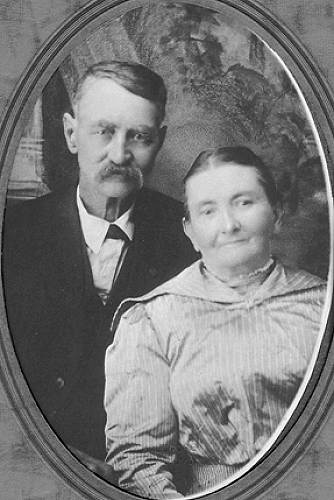
43 James and Julia Hawkins
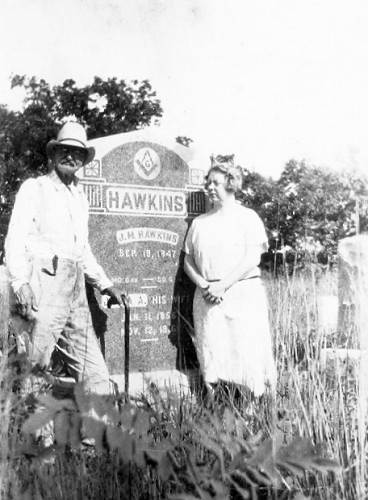
44 James Hawkins and daughter Nancy at tombstone before he died
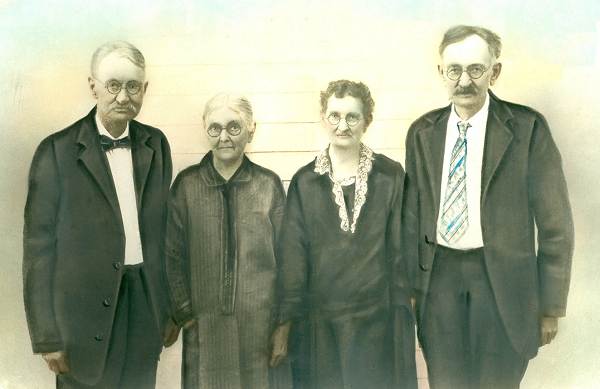
45 Siblings: James Hawkins, Mary Hawkins, Cynthia Hawkins Spearman and William Hawkins
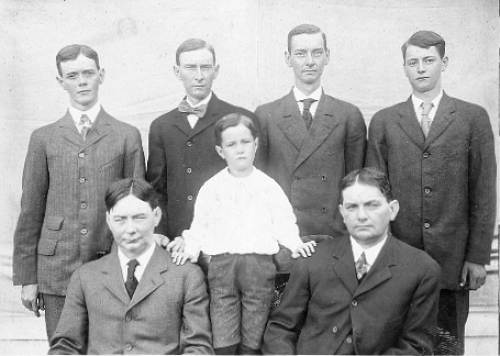
46 Sons of James
Back Row: Phil, Clinton, Clate and Perry Hawkins
Front Row: Ed, Ted and Carrol Hawkins
James Hawkins had the largest home in Brumley. Here is a photo of it one hundred years ago (photo 47):
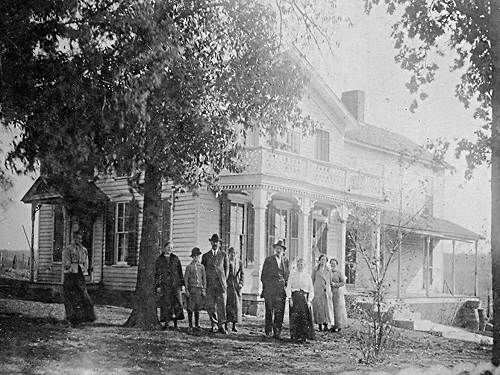
47 James Hawkins Home - 1915
Click image for larger viewA recent photo reveals it is still standing and housing a family but is in need of repair (photo 48).
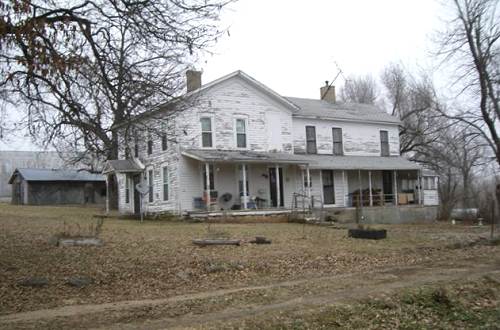
48 Home of James Martin Hawkins - 2010 Not many artifacts remain from the old home although Judy Hawkins did keep this large wall mirror (photo 49).
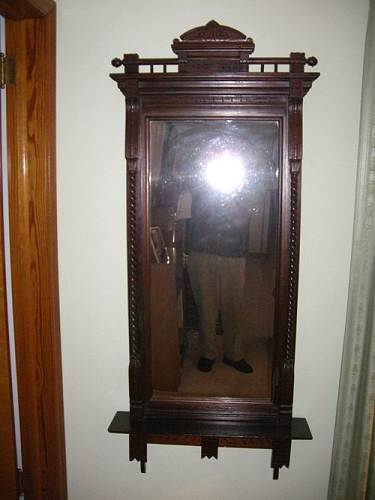
49 Wall Mirror Owned by James Hawkins
Just as James Hawkins was an influential man in Miller County so were his siblings. The story of one of those, Cynthia Hawkins Spearman, sister of James, is one of the most fascinating examples of courage, determination and perseverance you may ever read. This story is best told by our Society historian, Peggy Hake:
CYNTHIA HAWKINS SPEARMAN (photo 50)
1851-1943
Peggy Hake
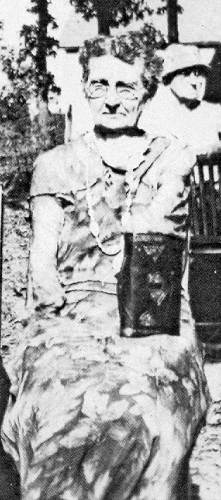
50 Cynthia Hawkins Spearman Cynthia Hawkins Spearman, age 86, was selected as 'Pioneer School Teacher' in Miller County's Centennial Pageant of 1937--a most appropriate selection!
Sometimes when I walk down that road to yesterday, I encounter some of the most remarkable people. One whom I would call 'extraordinary' was Miss Cynthia. She was born in Miller County in March 1851, a daughter of Presley and Sarepta (McCubbin) Hawkins. She was born in Glaize Township near the town of Brumley. Cynthia was a product of a fine, old Virginia family where for generations her ancestors lived. Her great grandfather, John Hawkins (1759-1831), was a soldier of the Revolutionary War. In the early 19th century, her Hawkins ancestors moved from Hampshire County, Virginia (now West Virginia) to Kentucky and located near Elizabethtown.
Her father, Presley Hawkins, was born in Virginia in 1819 and came to Miller County circa 1842 from Hart County, KY. He married Sarepta McCubbin in Miller County in 1843. They had several children including: James Martin Hawkins, Mary Catherine Hawkins, Cynthia Frances Hawkins, Dr. Zachariah Hawkins, William Lewis Hawkins, and Millard Fillmore Hawkins (photo 51).
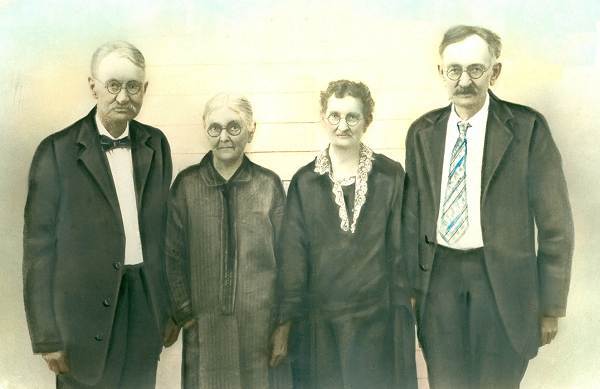
51 Siblings: James Hawkins, Mary Hawkins, Cynthia Hawkins Spearman and William Hawkins In 1859, Cynthia's father died and left her mother with the young children to rear alone.
At a young age, Miss Cynthia began her 40-year teaching career in the rural schools of Miller County. What made Cynthia Hawkins different from other women who taught schools in the 19th Century? At an early age, she lost both arms, just below the elbow, in a cane mill accident. Her mother, a widow, was operating the cane mill because most of the men of the area had volunteered to go off to war. The Civil War had begun to creep across the countryside and the women were left at home alone to perform the difficult farm work. It was molasses-making time and Cynthia was helping her mother and family members feed cane stalks into the mill. Her arms became caught in the rollers and when they finally freed her arms, they were mangled and crushed. Two days later, Dr. Anton Nixdorf decided her arms had to be amputated. A carpenter nearby had a small handsaw and it was used to amputate her arms. Talk about true grit!
When a young girl, perhaps 13 years old, she drove a covered wagon to Texas taking her ill mother and young brothers with her. In 1874, Cynthia's mother, Sarepta McCubbin Hawkins, died near Bosqueville, Texas. Shortly thereafter, Cynthia came back to Miller County and began her teaching career.
She did not consider herself handicapped nor did anyone who ever knew her. By grasping things between her elbows, she could do almost anything. She dressed and groomed herself, wrote, cooked, raised chickens, gardened, and even made quilts. Her school students verified that she could wield a 'mean hickory stick' if the occasion for discipline arose!
Cynthia was the first woman elected to a public office in Miller County. During 1895 and 1896, she served as County Superintendent of Schools. Over the years her Hawkins family was prominent in politics. Her brother, James Hawkins, was a state representative, county court judge, and collector. Her nephew, Charles R. 'Ted' Hawkins, was State Senator for many years and she was also related to Alvin P. Hawkins, a former Governor of Texas.
In 1885, at the age of 34, Cynthia married Zebedee Spearman, a widower with four children and 20 years her senior (photo 52).
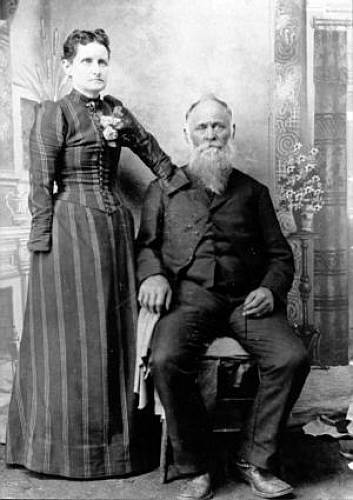
52 Cynthia Hawkins Spearman and Zebedee Spearman Zebedee was a son of Thomas and Nancy (Shelton) Spearman, natives of South Carolina. She never had any children of her own but helped to rear her stepchildren and grandchildren. In 1940, about 250 former students and friends gathered at the Brumley high school and honored Miss Cynthia on her 89th birthday. The high school gymnasium was dedicated in her honor. She told them how she had traveled to Texas in a covered wagon, later traveled by train and automobile, sailed on a ship while on the west coast, and finally flew in an airplane on a trip back home from California. She had certainly seen many changes in her lifetime.
Cynthia's husband, Zebedee Spearman, died in 1897 and she remained his widow for many decades. Miss Cynthia died in Miller County in July 1943 at the age of 92 years. She was buried at Hawkins cemetery, just a short distance east of Brumley, which is located in the same community where she was born in 1851 where she was born 92 years earlier.
Note: Cynthia never had any children of her own but she proved to be a wonderful step mother to Zebedee’s surviving children by his first wife, Mary E. Gardner. The children were Gilbert S. Spearman born c/1861; Alzena A. Spearman b. c/1863; Laura Alice Spearman b. c/1866; Willard S. Spearman 1867-1951; and Orlando W. Spearman 1870-1870. Mary Gardner Spearman died in April 1871 and is buried at the old Rankin Wright/Spearman cemetery in Richwoods township southwest of Iberia. Zebedee Spearman died in February 1897 and was buried beside his first wife in Rankin Wright /Spearman cemetery. His second wife, Cynthia Hawkins Spearman, was buried in Hawkins cemetery near other members of her Hawkins family.
One of the most amazing things Cynthia accomplished without hands or forearms was a quilt she made many years ago. Judy Hawkins displays the quilt in this photo (photo 53).
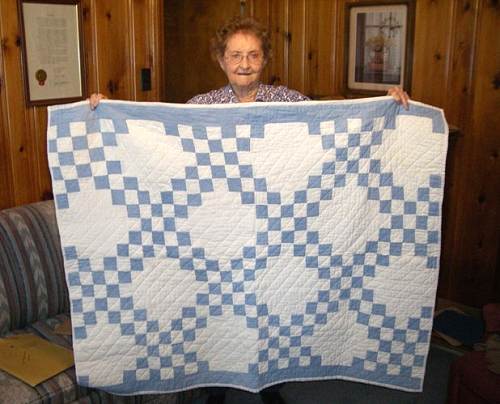
53 Quilt made by Cynthia Hawkins Spearman displayed by Judy Hawkins Judy wrote a short history of the quilt which I will copy here:
The quilt was made by my great Aunt Cynthia Hawkins Spearman. As you can see it is very plain but it has quite a history. Aunt Cynthia was born in 1851 and died in 1943. When she was around nine years old both of her hands were crushed in a molasses mill and her arms had to be amputated one to two inches below her elbows. She held things in the bends of her elbows and this enabled her to do most things. She made this quilt and many others by cutting out the pieces with a sharp pocket knife and sewing them together on the sewing machine. The quilts were quilted by the women of the Christian Church.
The quilt might be appropriate for a meeting on handicapped people; however, she did not consider herself to be handicapped nor did those who knew her. She taught school for many years and was active in church and civic affairs.
It was a privilege for me to know her and I am very proud of my quilt.
Judy Hawkins
In 1937, Cynthia was scheduled to present a class on “Pioneer Days” as part of the Miller County Centennial Celebration. She was visiting her brother in Wichita at the time. Rather than make a long car trip she chose to take a private airplane. In this copy of an article in the Autogram published shortly before the Centennial Event in 1937 you can read more about it (photo 54).
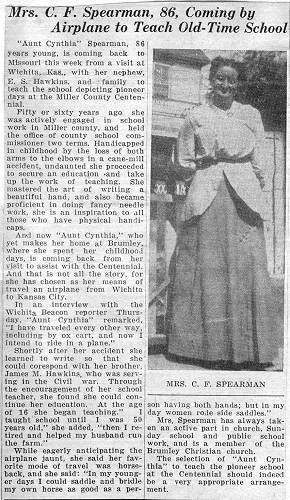
54 Cynthia Hawkins Spearman Airplane Trip
Click image for larger view
Judy Hawkins’ father, Charles Roosevelt (familiarly called “Ted” because of his middle name), is the Hawkins most recently remembered by long time Miller County residents. He has the distinction of being one of only five Miller County residents to hold the position of a State Senator. Ted’s wife, Mable Hawkins, wrote a biography of her husband which I will copy here:
C. R. (Ted) Hawkins (photo 55)
By Mrs. Mabel Hawkins
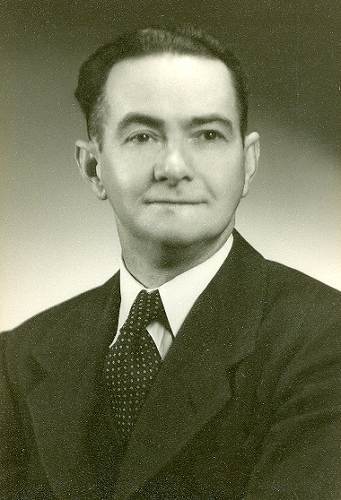
55 Senator Ted Hawkins C. R. (Ted) Hawkins was a son of James and Julia (Martin) Hawkins and a grandson of Presley and Serepta (McCubbin) Hawkins. He was born 29 October 1900 at Brumley, Mo. On August 18, 1920, he married Mabel Claire Foster in Warrensburg, MO.
They reared four daughters, Mary Hawkins Collins, Judy Hawkins, Teddy Jean Hawkins, and Dr. Sue Hawkins. Ted Hawkins became assistant cashier of the Bank of Brumley in 1920, cashier in 1934, and was President from 1956 until his death in 1959. He served on the Brumley School Board for over twenty-five years; was superintendent and teacher, Brumley Christian Church; and past master of Brumley Masonic Lodge.
C. R. (Ted) served as Chairman, Miller County Republican Central Committee for many years and was much in demand as a speaker statewide. He served in the Missouri Senate from 1945 to 1959. Senator Hawkins was one of only five men who was a resident State Senator from Miller County since its organization in 1837. The other four men included Thomas Scott 1858; James H. Todd 1869, 1871; Frank DeVilbliss 1905, 1907; and W. S. Allee 1909-1915.
The father of Senator Hawkins, James M. Hawkins, was a leader in Republican politics in Miller County. He served as Deputy Sheriff and Deputy Collector from 1872 to 1876; was elected County Judge in 1888; and served as State Representative in the 36th General Assembly in 1881-1882.
Although Senator Hawkins served on numerous Senate committees, he was most interested in the field of education. He sponsored the school reorganization law which reduced the number of districts from 8500 to 2600. He led the fight for the School Foundation Program enacted in 1955. He was the prime mover in obtaining legislation to better the lot of children who are retarded. Senator Hawkins was twice recipient of the St. Louis Globe-Democrat Award for Meritorious Public Service as the Senator Most Effective in Debate; once in 1958 and again posthumously, to Mrs. Hawkins, in 1960.
The most amazing thing about Ted’s win in his first race for State Senate in 1944 was that almost all the other Republicans in Missouri were losing since Franklin Roosevelt, whose administration was still very popular, went on to win the state and national election to gain his fourth term as President. Support locally for Ted was so strong that the Miller County Autogram wrote an editorial supporting his candidacy for State Senate as early as the primary race, something that was very unusual for the local paper. The editorial is interesting because the issue mainly was whether Roosevelt’s “New Dealism” should be continued, something we are arguing about even now concerning the extent to which the public wants the government involved in its affairs. You can read that editorial here (photo 56).
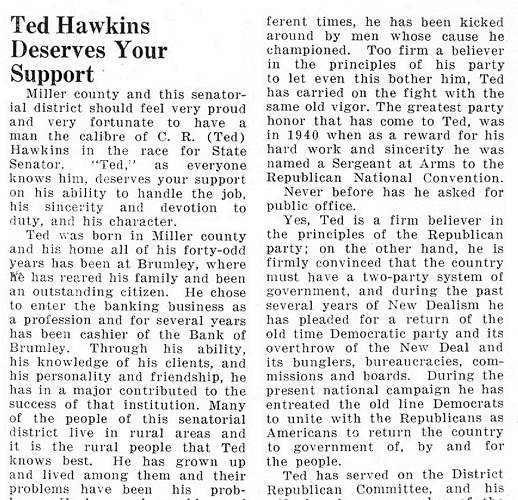
56 Miller County Autogram - April 27, 1944
Click image for larger view of complete articleIn his second candidacy for reelection to the position of State Senator in 1948 another editorial was placed in the Autogram by its new owner, Jac Zimmerman, which reiterated many of the same points made in the editorial written four years before. You can read it in this copy from the paper (photo 57):
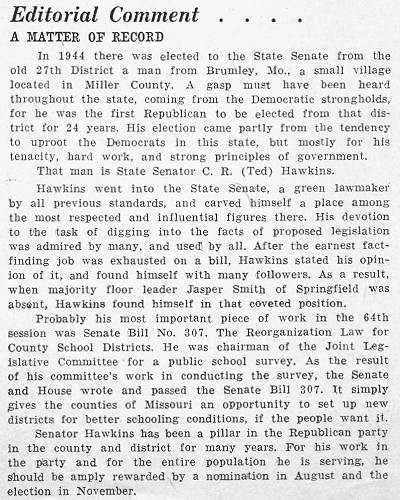
57 Editorial by Jac Zimmerman
Click image for larger viewHere is a collage of photos of Ted having to do with his political activities as well as a couple with his sister, Nancy, from the collection of Judy Hawkins (click on the thumbnail images for a larger view) (photos 58 - 66):
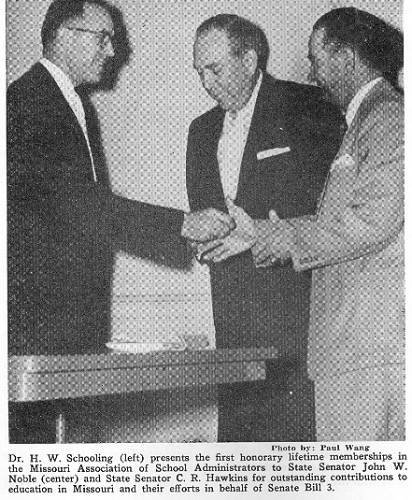
64 Honorary Award
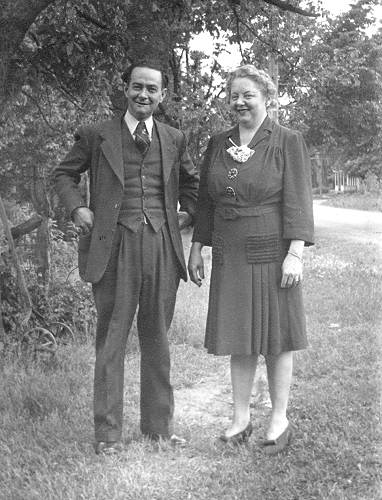
65 Ted and Sister Nancy Hawkins - 1950
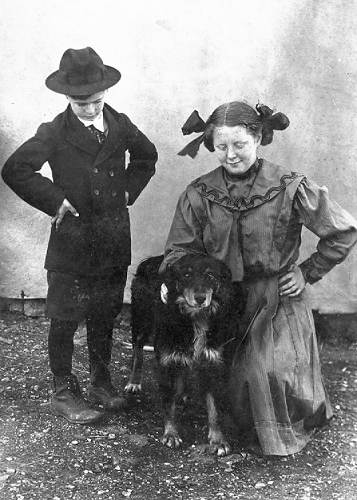
66 Ted and sister Nancy Hawkins with dog
(Which later died and Ted preached funeral)
The Hawkins originally are of English descent. Here are a couple of websites which trace some of the early Hawkins down to our Miller County Hawkins family:
http://awt.ancestrylibrary.com/cgi-bin/igm.cgi?op=REG&db=gwt1&id=I7733&ti=5542
http://worldconnect.rootsweb.ancestry.com/cgi-bin/igm.cgi?op=REG&db=ladyhawk03&id=I0653
Here is a copy of the Hawkins coat of arms and narrative (photo 67):
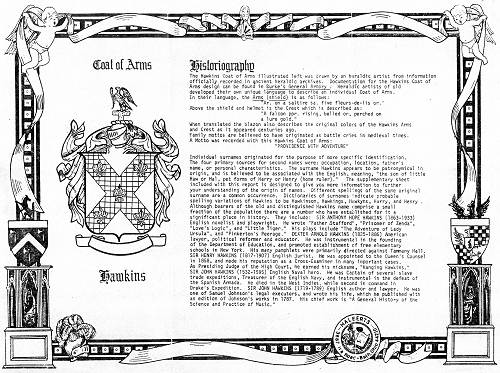
67 Hawkins Coat of Arms
Click image for larger viewAnd so we come to the end of this rather long narrative about the Hawkins family; but then, when much good is accomplished in life, it seems appropriate to present the details so future generations might learn from the past.
Last week we were very fortunate to have the volunteer assistance of 12 members of the AmeriCorps group from Eldon in our probate file preservation project (photo 68).
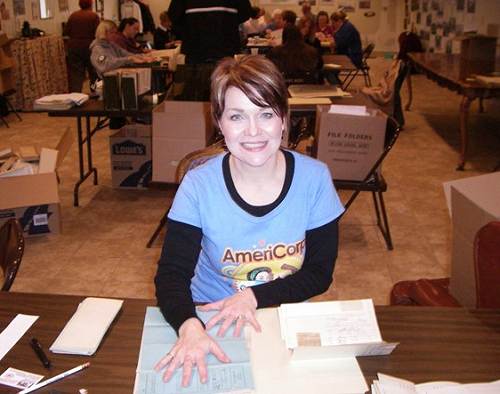
68 Daphne Partridge and AmeriCorps We are so grateful to Daphne Partridge, Community Research Director of PAVE AmeriCorps and the excellent volunteers she makes available to us for our Monday volunteer days. The main emphasis of AmeriCorps is to enrich the education of students as well as other community activities.
Tammy Witherspoon of the Eldon Advertiser was present when AmeriCorps was here at the museum last week on Martin Luther Day as an example of public service in his memory.
Here is the article Tammy wrote for the Advertiser last week:
PAVE volunteers help preserve Miller County’s past
Tammy Witherspoon
While other people were getting to sleep in on Martin Luther King’s birthday, members of the Eldon PAVE AmeriCorps join citizens around the nation and other AmeriCorps programs in service today to Make It A Day On instead of a day off in honor of Martin Luther King.
PAVE AmeriCorps members normally serve in Eldon R-1 schools, providing academic interventions to at-risk students. On MLK day this year, they reached out to the greater community and joined other volunteers at the non-profit Miller County Museum to assist in their efforts to preserve historical documents.
Eldon PAVE/AmeriCorps volunteers were at the museum at 9 a.m. sharp to help go through and preserve museum documents. Community Resource Director Daphney Partridge said the volunteers are fascinated by the work.
“They were excited to find sales slips for slave owners and land transfer documents,” said Partridge.
PAVE/AmeriCorps volunteers usually work full-time with at-risk students.
Partridge was surprised to find out from Miller County Historical Museum Director Nancy Thompson, that sheets of paper used to preserve the documents cost $120 apiece. Thompson said Miller County residents really take a strong interest in their history.
“Miller County folks are really involved with their heritage,” said Thompson. “And this preservation effort will help residents be able to access the documents they need.”
Eldon R-1 offers all members of our community the opportunity to serve. Volunteers are encouraged to donate their time and talents to support students, staff, and our schools.
If you have questions about this organization you can refer to the information on her personal card which I have copied here (photos 69 and 70):

69 Americorps
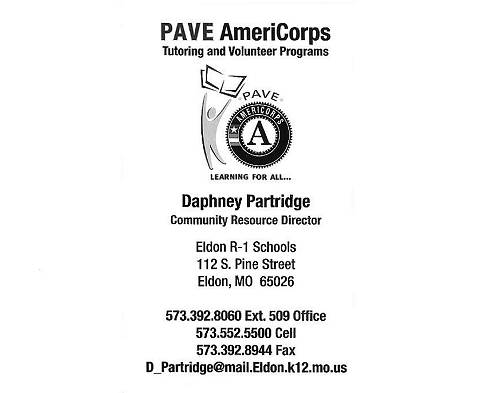
70 Americorps
We are very happy to announce that Waldo Sherril Steen and his wife, Alice Faye Pemberton Steen (photo 71), natives of Iberia but now residing in Texas, recently made a very generous donation to our Miller County Historical Society Foundation which will greatly increase the financial viability of our museum for its ongoing expenses and operation. The announcement of the gift was made in last week's Eldon Advertiser and Miller County Autoram Sentinel newspapers. We have set up the foundation as a vehicle for those who wish to donate funds to our museum to have available to them a tax saving vehicle to do so. Just in the last month we received notification from the state that we now have a state approved foundation for these types of gifts. Here is the article published last week in our local newspapers about Sherril and Alice's gift as well as the photograph which accompanied it:
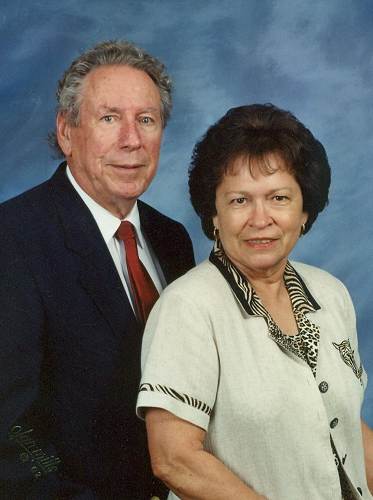
71 Waldo and Alice Steen MCHS Foundation Receives Jump Start
Waldo Sherril Steen and his wife, Alice Faye Pemberton Steen, have made the MCHS Foundation the beneficiary of their IRA. Meanwhile, they will donate the required minimum distribution ($11,500 in 2010) to the Miller County Historical Society each year. The objective of the Foundation is to provide members and friends of the MCHS with a means to make gifts which will continue to support the MCHS’s mission in perpetuity. The Foundation’s funds will be managed professionally for growth, with the annual distribution (about 5%) going toward meeting the MCHS’s annual operating expenses. Therefore, the Foundation will assure a bright financial future for the MCHS.
The Steen’s currently live in Texas but they return to Miller County frequently to visit family. The MCHS has created one of the best pioneer museums in the Midwest. “Joe and Judy Pryor and their team are heroes for spearheading the effort to preserve the stories and family heirlooms of our ancestors who settled in Miller County when it was new territory. Alice and I are proud that we can support them in their efforts to create and maintain a museum that features our ancestors,” says Sherril Steen.
“The farm house I grew up in was approximately 1500 feet from the slave cabin that is displayed outside the Museum. We called it the Smoke House. I was 58 years old before Sue Steen Cates told me Great Great Grandpa Williams built it for his slaves. My father told me tragic Civil War stories about the Williams family who fought for the Confederacy, but he never told me they owned slaves. It was a family secret.” says Sherril Steen.
The MCHS Museum holds a special place in Alice’s heart too. It preserves the stories and handmade quilt of her great grandmother, Fannie Williams Pemberton, the daughter of John Williams Jr. who married a “Damn Yankee” while her brothers and father fought for the Confederacy during the Civil War. She stood up to the bushwackers when they came to burn their house down, “WAIT until we get the new stove out!” Fannie had the courage and strength (along with her sister Martha) to protect her younger siblings, run an 800 acre farm, keep the family fed and pay the taxes while the “men folk” were fighting for the South.
Alice and Sherril have issued a challenge to other descendants of their home county to match their donation. They agree, “The Miller County Historical Society deserves our support and we pray that this gift will serve as a catalyst for others to follow suit.”
That’s all for this week.
 Joe Pryor
|



